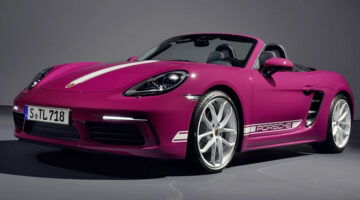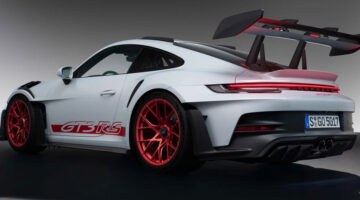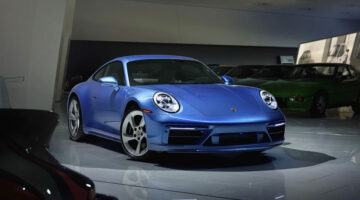At 48, the Porsche 911 Carrera is younger than ever, and might we say… looking damn fine again! There have been a couple of very clear wobbles during the 911’s history and this, thankfully, is not one of them. The completely redesigned icon is a stunningly pretty thing with its flat, stretched silhouette, yet as with every generation (yes,996 included) it remains unmistakably a 911.
Some say that Michael Mauer has the easiest job in the world – we reckon it might just be the toughest. Playing with an icon and being successful takes skill and balls.
Press Release >>>
The completely redesigned generation of the sports car icon is stepping into the limelight with its flat, stretched silhouette, exciting contours and precisely designed details, yet from the very first glance it remains unmistakably a 911. True to the 911 tradition, the distinctive Porsche design language with its tendons and muscles exudes power and elegance.
The 100 millimetre (~ 3.9 inches) longer wheelbase and reduced height combined with the up to 20-inch wheels underpin the athletic appearance. At the same time, the typical sports car compact exterior dimensions were retained. Seen from the front, the eye is drawn to the 911’s trademark wide-arched wings. They emphasise the wider front track, so that the new 911 Carrera models sit even more solidly on the road. The remodelled exterior mirrors are accommodated on the upper edge of the door and not as before on the mirror triangle. Not only is this aerodynamically advantageous, it also emphasises the new design line and visual impression of width.
The all-new, lightweight body is an intelligent aluminium-steel construction. It is responsible for a significant proportion of the weight reduction of up to 45 kilograms. Combined with significantly greater rigidity. Aerodynamic optimisation — including a wider, variably extending rear spoiler — enabled the new 911 Carrera’s lift to be reduced yet further while retaining a very good Cd value.
To complement the modern exterior design, the Porsche designers created an interior, the architecture of which takes its cue from the Porsche Carrera GT. The driver is now even more closely integrated with the cockpit thanks to the centre console rising up to the front with the high-mounted shift lever or gear selector located especially close to the steering wheel in typical motorsport fashion. Classic Porsche elements are also to be found inside, as they are on the outside: the instrument cluster with five round instruments — one of them a high resolution multifunction screen, the central rev counter and the ignition lock to the left of the steering wheel.
Setting the standard in its class, as it has for generations, the new 911 Carrera and Carrera S raise the performance and efficiency bar yet another notch. All versions get by with significantly less than ten litres of fuel per 100 kilometres (28 mpg imp.). Fuel consumption and emissions are up to 16 per cent lower compared with its predecessor. Among other things, this is achieved by systems and functions such as auto start/stop, thermal management, electrical system recuperation, the world’s first seven-speed manual transmission and — in conjunction with the Porsche-Doppelkupplungsgetriebe (PDK) — sailing as it is called. The new electro-mechanical power steering offers not only Porsche’s typical precision and feedback but also helps to increase efficiency and reduce fuel-consumption.
For example, the 911 Carrera with the new 350 hp (~ 257 kW) 3.4-litre boxer engine and optional PDK consumes a mere 8.2 litres per 100 kilometres (~ 34 mpg imp.) based on the New European Driving Cycle (NEDC) — 1.6 l/100 km (~ 6 mpg imp.) less than its predecessor. Also, at 194 g/km CO2, it is the first Porsche sports car to make it below the 200 g/km mark. With the 911 Carrera S as well, with its 3.8-litre boxer engine and what is now 400 hp (~ 294 kW), fuel consumption when paired with the optional PDK is reduced by 14 per cent or 1.5 l/100 km (~ 5 mpg imp.) to 8.7 l/100 km (~ 32 mpg imp.) despite 15 hp (~ 11 kW) more power. That equates to CO2 emissions of 205 g/km.
At the same time there are performance improvements in both models. The 911 Carrera S with PDK manages to accelerate from nought to 100 km/h (~ 62 mph) in 4.3 seconds. Pressing the Sport Plus button on the optional Sport Chrono package cuts that to 4.1 seconds. The 911 Carrera with PDK needs only 4.6 seconds (Sport Plus 4.4 seconds) to sprint from a standing start to 100 km/h (~ 62 mph).



